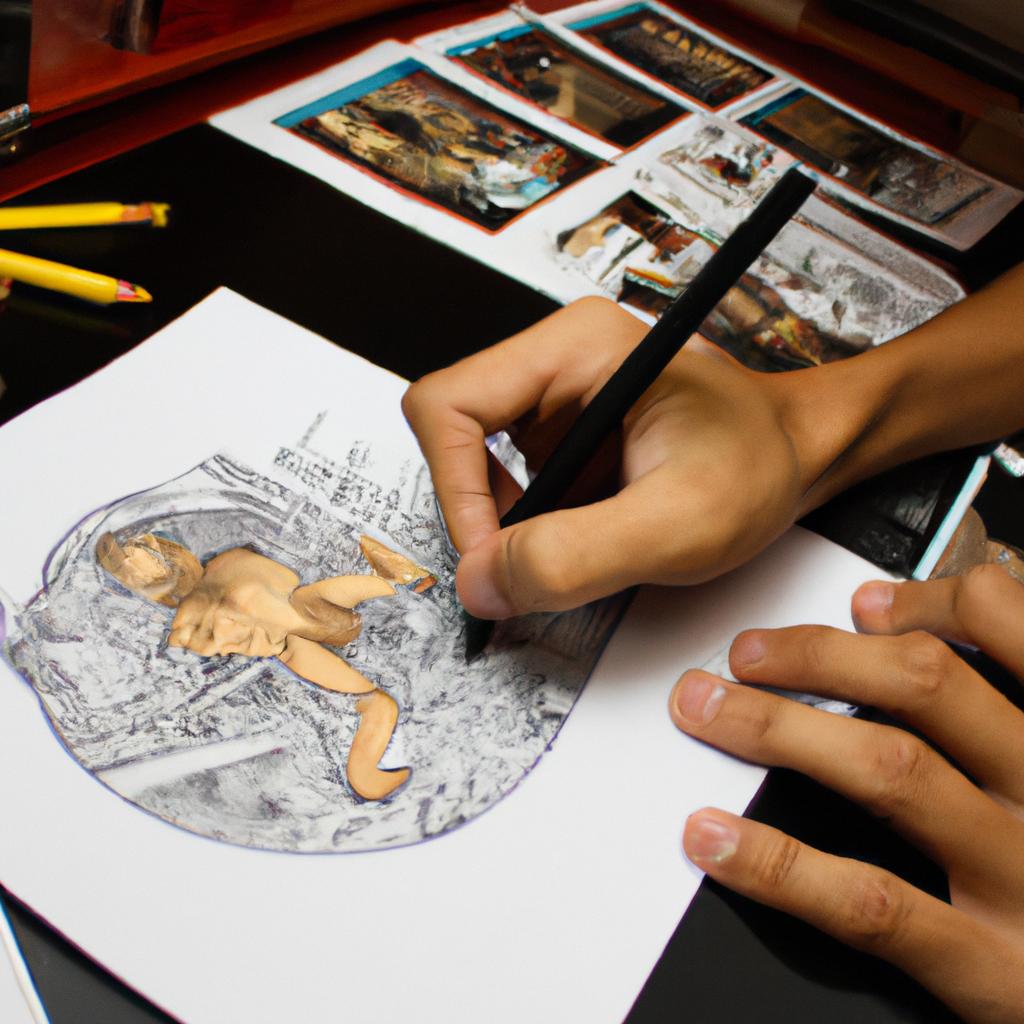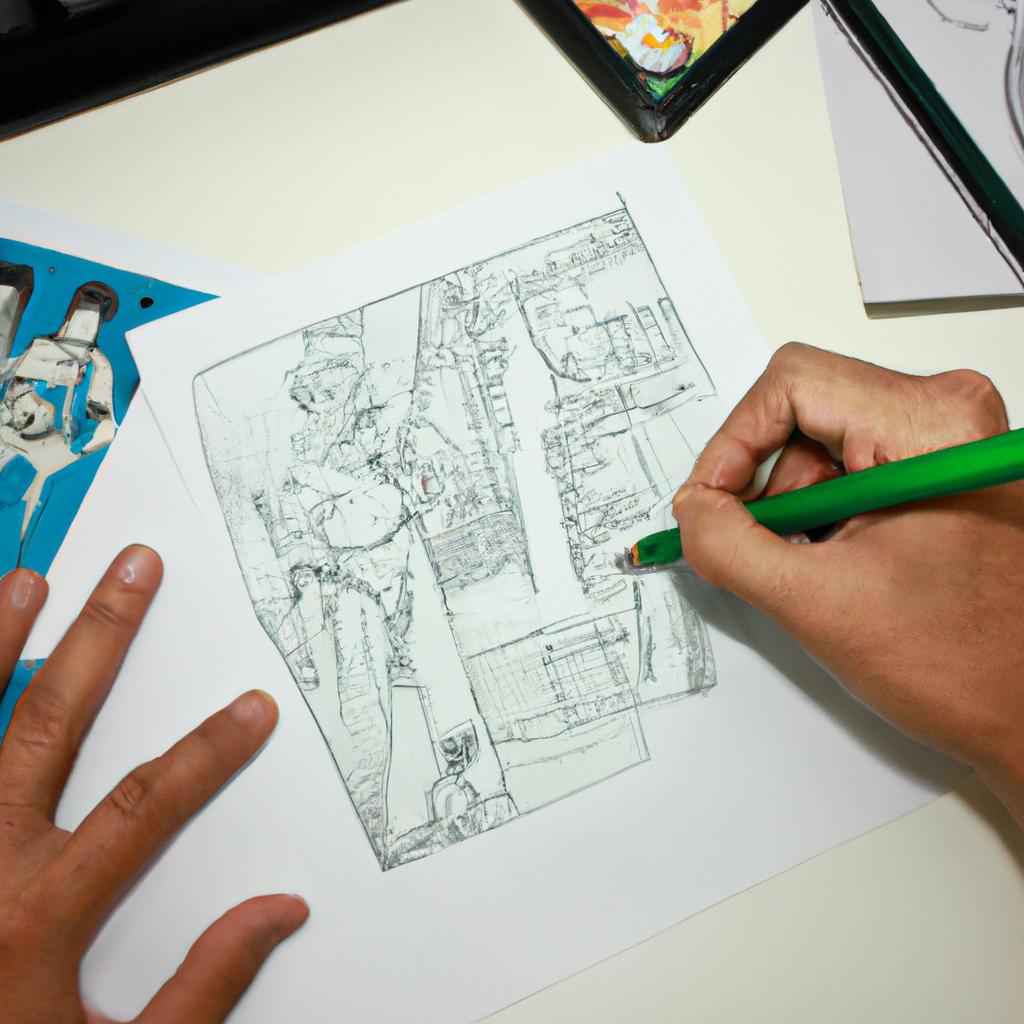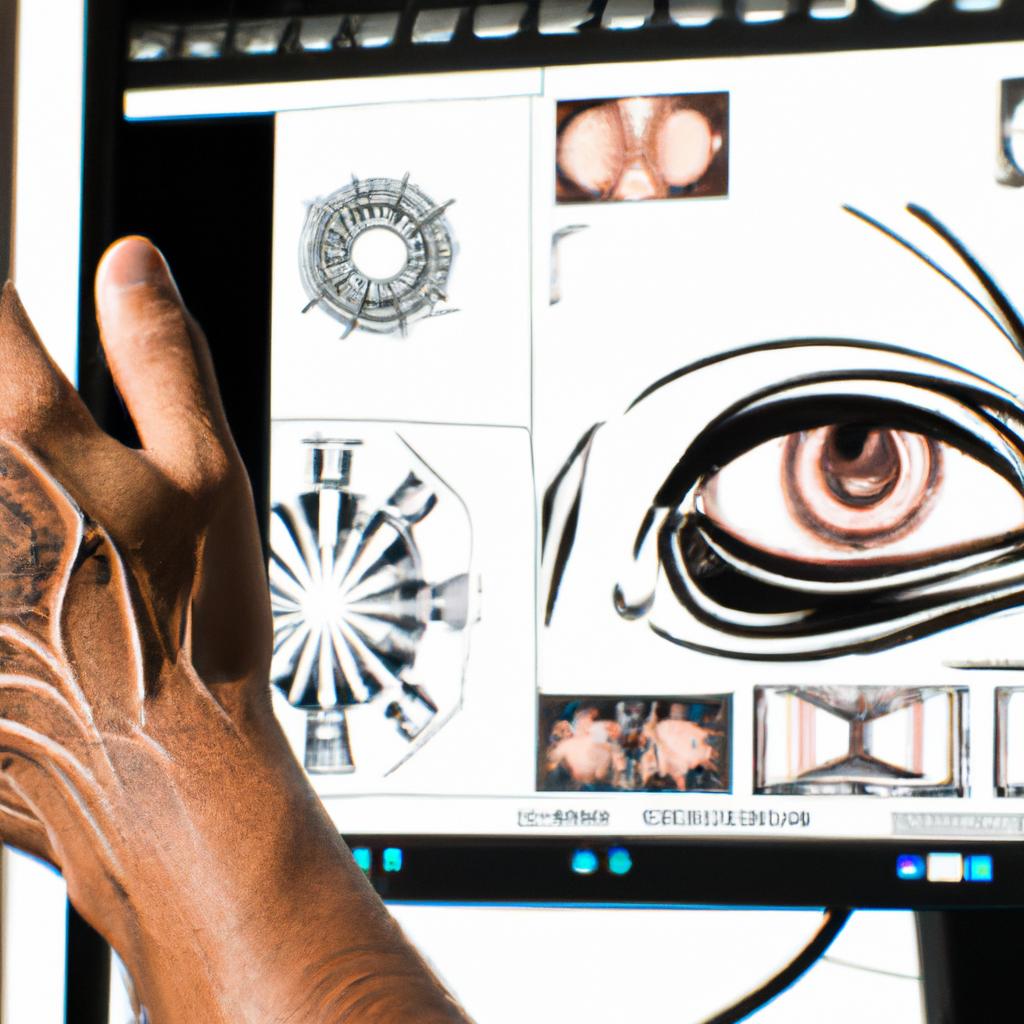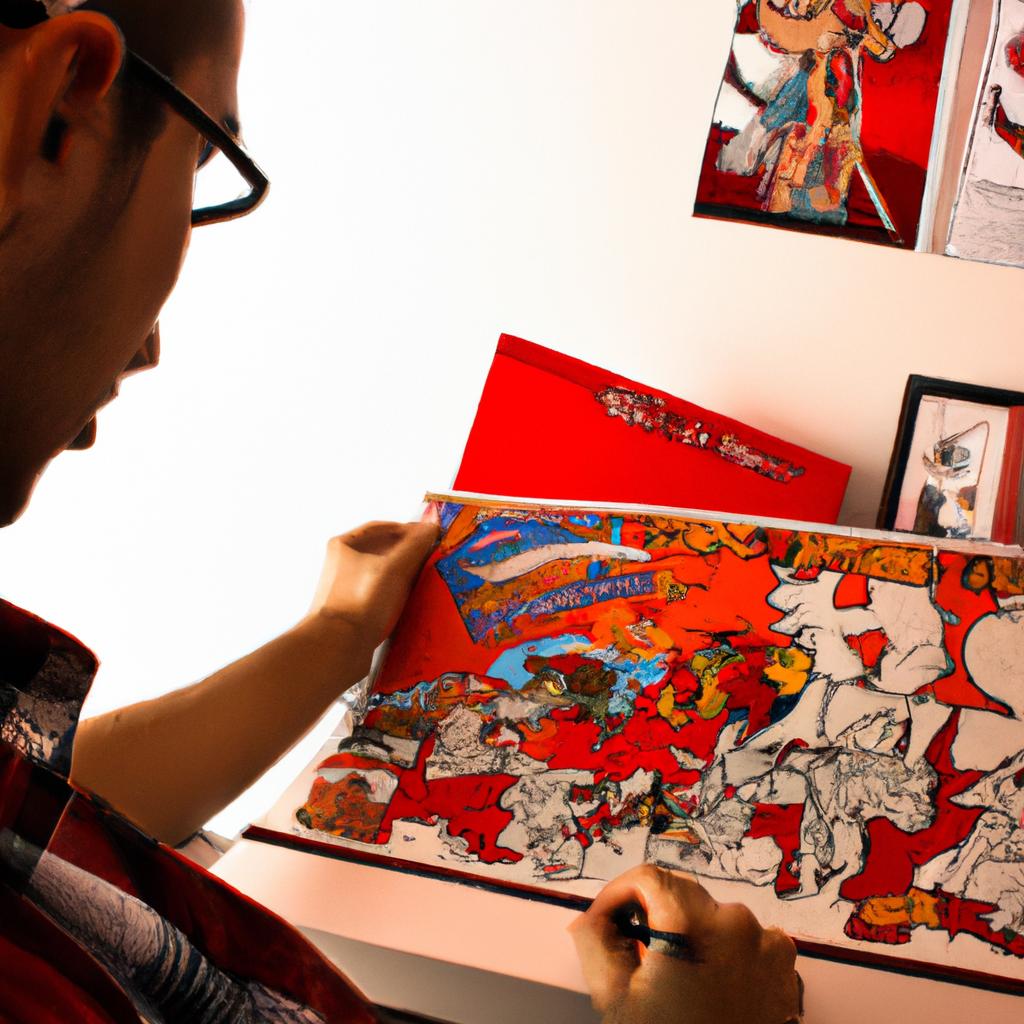The art of inking plays a crucial role in the realm of comic book illustration, allowing artists to bring their sketches and drawings to life with precision and depth. Whether it be defining the outlines, adding shading, or creating texture, mastering the inking technique is essential for comic book artists seeking to enhance the visual impact of their work. This article aims to provide a comprehensive guide for aspiring artists by exploring various aspects of inking technique and offering valuable insights into how professionals can achieve mastery in this craft.
Consider the case study of Jane, an up-and-coming comic book artist who struggled with perfecting her inking skills early on in her career. Despite having a keen eye for composition and storytelling, she found herself frustrated by her inability to effectively translate her pencil drawings onto paper using ink. However, through persistence and dedicated practice, Jane gradually honed her understanding of different tools and techniques available for inking. By experimenting with line weights, brush strokes, cross-hatching methods, and other fundamental principles discussed throughout this guide, she was able to elevate her artwork to new heights and captivate readers with visually striking panels.
In order to assist aspiring comic book artists like Jane on their journey towards mastering the art of inking, this article will delve into various tools commonly used in the inking process, such as pens, brushes, and markers. It will discuss the pros and cons of each tool, helping artists determine which one suits their style and preferences best.
Furthermore, this article will explore different techniques for achieving various effects in inking. It will cover topics like creating smooth and consistent lines, adding depth through shading and cross-hatching, and incorporating textures to bring life to characters and backgrounds.
Moreover, understanding the importance of composition in comic book illustration is crucial for effective inking. This article will provide insights into how artists can use inking techniques to enhance storytelling by guiding the reader’s eye through panels and emphasizing important elements within a page.
Additionally, this guide will tackle common challenges that aspiring artists may face while inking, such as avoiding smudging or making mistakes that are difficult to fix. It will offer practical tips and tricks to overcome these obstacles and achieve clean, professional-looking results.
Lastly, this article will touch upon digital inking techniques for those who prefer working digitally. It will explore popular software options available for digital inking, along with tips on using layers and various brush settings to achieve desired effects.
By delving into all these aspects of the art of inking, this comprehensive guide aims to equip aspiring comic book artists with the knowledge and skills necessary to master this essential technique. Whether you’re just starting out or looking to refine your existing skills, this article is designed to be a valuable resource on your artistic journey towards creating captivating comic book illustrations.
Understanding the Basics of Inking
To truly master the art of inking, it is essential to understand its fundamentals. In this section, we will delve into the key aspects that every comic book artist and illustrator should be familiar with when it comes to inking. By comprehending these foundational principles, you will be equipped with a solid understanding of how to bring your illustrations to life through the power of ink.
Imagine you have just completed a beautifully sketched illustration for a comic book panel. The lines are crisp, the composition is dynamic, and the characters appear ready to leap off the page. However, without proper inking technique, all your hard work may fall short of its potential impact. This example showcases how vital inking is as it enhances and refines your artwork, adding depth and dimensionality.
In order to achieve successful inked artworks, several factors come into play:
- Line Weight: The variation in line thickness can create visual interest and guide the viewer’s eye across different elements of an illustration.
- Texture: Skillful use of textures can evoke specific emotions or moods within a scene.
- Hatching and Cross-Hatching: These techniques involve using parallel or intersecting lines to add shading and volume to objects or figures.
- Ink Application Techniques: Understanding various methods such as stippling (creating patterns with dots), dry brushing (using minimal amounts of ink), or wet-on-wet application (allowing inks to blend) can greatly enhance your artistic expression.
By employing these techniques effectively, artists can transform their initial sketches into captivating visuals that command attention from readers and viewers alike.
Now armed with an overview of the basics involved in inking, let us explore another crucial aspect: choosing the right tools for producing professional-grade results. Through careful consideration of suitable pens, brushes, papers, and other materials specifically designed for inking purposes, artists can further refine their skills and elevate the overall quality of their work. So, let us delve into the realm of tools and equip ourselves with the knowledge necessary to make informed decisions in our creative endeavors.
Choosing the Right Tools for Inking
Mastering Inking Technique: A Guide for Comic Book Artists and Illustrators
Understanding the Basics of Inking – Part 2.1
Once you have familiarized yourself with the basic concepts of inking, it is time to delve into the world of tools that will aid you in bringing your artistic vision to life. Choosing the right tools for inking requires careful consideration, as each artist has their own preferences and techniques. Let’s explore some key factors to keep in mind when selecting your arsenal.
Imagine this scenario: You are an aspiring comic book artist who prefers a traditional approach to inking. Your aim is to achieve bold and expressive lines while retaining intricate details. To accomplish this, you decide to try out different pens, brushes, and nibs available on the market. After experimenting extensively, you discover that a combination of a flexible brush pen combined with a fine-tipped technical pen suits your style best. This allows you to effortlessly transition between thick and thin lines, resulting in dynamic illustrations.
When deciding which tools are most suitable for your needs, consider these essential points:
- Precision: Look for tools that offer precise control over line thickness and allow for intricate detailing.
- Comfort: Find instruments that feel comfortable in your hand during long drawing sessions, reducing strain or fatigue.
- Versatility: Opt for tools that can be used interchangeably to create various effects and textures.
- Durability: Invest in high-quality materials that withstand frequent use without compromising performance.
To assist you further in making an informed decision about which tools align with your artistic goals, refer to the table below comparing popular options:
| Tool | Pros | Cons |
|---|---|---|
| Brush Pens | Fluid strokes | Require practice |
| Technical Pens | Precise lines | Limited line width |
| Fountain Pens | Vintage aesthetic | May require maintenance |
| Nibs | Customizable line quality | Require separate holders |
Now equipped with a deeper understanding of the basics and an overview of various tools, you are ready to venture into the next step: mastering line weight and thickness. By skillfully manipulating these aspects, you will be able to add depth and dimension to your artwork while captivating your audience.
Mastering Line Weight and Thickness – Part 2.2
Mastering Line Weight and Thickness
Section Transition:
Having learned about the importance of choosing the right tools for inking, let us now delve into the next crucial aspect of mastering this technique – line weight and thickness. Understanding how to manipulate these elements effectively can greatly enhance the visual impact of your artwork and bring it to life.
To illustrate the significance of line weight and thickness, consider a hypothetical scenario where an artist is working on a comic book panel depicting a dynamic action sequence. In this particular scene, a superhero is engaged in an intense battle against a formidable enemy. By varying the line weight and thickness throughout the panel, the artist can convey a sense of movement, depth, and emotion that intensifies the overall impact on readers.
To achieve such effects, artists must be mindful of certain key considerations when manipulating line weight and thickness:
- Contrast: Utilize variations in line weight to create contrast between different objects or areas within your illustration. This helps draw attention to focal points and adds dimensionality.
- Emphasis: Increase line weight in areas you want to highlight or emphasize, such as defining strong contours or adding emphasis to important features like facial expressions or significant objects within the composition.
- Depth: Gradually increase or decrease line thicknesses to suggest depth in your artwork. Thicker lines are typically used in foreground elements while thinner lines are employed for background details.
- Texture: Experiment with different brush strokes and techniques to create texture through varied line weights. This can add richness and complexity to your illustrations.
By skillfully employing these principles, artists can elevate their work from mere sketches to captivating pieces of art that evoke emotional responses from viewers.
Table Example:
| Considerations | Examples |
|---|---|
| Contrast | Thick lines vs thin lines |
| Emphasis | Strong contour outlines |
| Depth | Varying thicknesses |
| Texture | Diverse brush strokes |
Incorporating these considerations into your inking process will enable you to create visually engaging illustrations that captivate and resonate with the audience.
With a firm understanding of line weight and thickness, we can now explore the fascinating realm of creating depth and dimension with shadows.
Creating Depth and Dimension with Shadows
Section: ‘Creating Depth and Dimension with Shadows’
In the art of inking, mastering the technique of creating depth and dimension with shadows is crucial for comic book artists and illustrators. By skillfully incorporating shadows into their artwork, they can bring their characters and scenes to life, adding a sense of realism and visual interest. Let’s explore some key concepts and techniques that can help artists achieve this effect.
One effective way to create depth through shadows is by understanding light sources and how they interact with objects. For example, consider a scene where a superhero stands under a streetlamp at night, casting long shadows on the ground. By accurately depicting the direction and intensity of the light source, artists can effectively convey both the presence of the light itself and the resulting shadow. This attention to detail adds credibility to the illustration while enhancing its overall impact.
To further enhance the three-dimensionality of an artwork, artists often utilize various shading techniques. These techniques include hatching (the use of parallel lines), cross-hatching (intersecting sets of parallel lines), stippling (small dots or specks), or contour shading (following the contours of an object). Each method has its own unique aesthetic qualities, allowing artists to experiment with different styles depending on their desired effect.
When applying shading techniques, it is essential to consider contrast as well. Contrasting values between areas of illumination and shadow emphasize depth within an image. Darker shadows can be achieved through heavier ink application or layering multiple strokes together, while lighter shades can be created by using less pressure or thinner lines. The careful balance between light and dark enhances visual impact, drawing attention to focal points and guiding viewers’ eyes throughout the composition.
Emotional Response Inducing Bullet Point List:
- Amplify drama by utilizing stark contrasts between light and shadow.
- Evoke mystery by strategically placing obscured elements within deep shadows.
- Convey emotion by portraying subtle facial expressions enhanced by shadow play.
- Create a sense of movement and energy through dynamic shadows that mimic the flow of action.
| Techniques | Description |
|---|---|
| Hatching | Parallel lines used to create shading, varying in length and density. |
| Cross-hatching | Intersection of parallel lines to form shaded areas with different textures. |
| Stippling | Creation of shading using small dots or specks. |
| Contour Shading | Following the contours of an object to create smooth transitions between light and shadow. |
By mastering the art of creating depth and dimension with shadows, artists can elevate their illustrations, infusing them with realism and visual interest. The next section will delve into another important aspect of inking: incorporating texture and detail into artwork, which further enhances its overall impact without compromising clarity or coherence.
Incorporating Texture and Detail in Inking
Shadows play a crucial role in adding depth and dimension to inked illustrations. By strategically incorporating shadows, comic book artists and illustrators can enhance the visual impact of their work. Let’s examine how shadows can be utilized effectively through various techniques.
One technique is cross-hatching, where lines are drawn closely together to create areas of darkness, resulting in a textured appearance. For instance, consider a scene depicting a dimly lit alleyway. By using cross-hatching to darken certain areas, such as the corners or behind objects, an artist can convey a sense of mystery and suspense. This not only adds depth but also enhances the overall atmosphere of the illustration.
To further emphasize depth, artists often employ different levels of shading intensity. By varying the thickness and spacing of lines within shadowed regions, they can achieve gradation that conveys distance or three-dimensionality. For example, imagine an action-packed panel featuring superheroes engaged in battle against towering robots. Using this technique, the artist could apply heavier shading on elements that are closer to the foreground, while gradually lightening it for objects farther away. The result would be a visually striking composition that captivates readers’ attention.
Incorporating shadows effectively relies on understanding light sources and their interactions with objects within a composition. Here are some key considerations:
- Positioning: Determine where the primary light source originates from and cast shadows accordingly.
- Angle: Take into account how light falls onto surfaces at different angles to accurately depict highlights and shadows.
- Reflections: Consider reflective surfaces like water or glass that may alter the direction or intensity of shadows.
- Contrast: Experiment with contrasting dark and light areas to create more dramatic effects.
By mastering these techniques and understanding these principles, comic book artists and illustrators can elevate their art by creating compelling compositions rich in depth and dimension.
Continuing the journey towards mastering inking techniques, the next section focuses on refining skills to achieve professional-quality results. Aspiring artists will learn how to further enhance their inked illustrations by paying attention to fine details and perfecting line work. Let’s delve into the intricacies of refined inking techniques that separate amateurs from professionals.
Refining Inking Techniques for Professional Results
Transitioning smoothly from the previous section’s focus on texture and detail, we delve further into advanced inking techniques to achieve dynamic illustrations. Let us examine an example of how these techniques can be applied effectively:
Imagine a comic book panel featuring a fierce battle scene between two superheroes. To capture the intensity and motion of this moment, the artist utilizes various advanced inking techniques such as cross-hatching, stippling, and contour lines. The use of cross-hatching creates depth by layering fine parallel lines at different angles, while stippling adds texture through small dots or dashes. Furthermore, by incorporating contour lines along the outlines of characters and objects, the artist brings out their three-dimensional form.
To master advanced inking techniques that enhance visual impact and storytelling capabilities, consider the following essential practices:
- Vary line widths: Experiment with thick and thin lines to convey depth, volume, and emphasis.
- Explore brushwork: Utilize brushes of different sizes to create varied textures and strokes.
- Play with negative space: Leverage empty areas around inked elements to emphasize focal points.
- Experiment with unconventional tools: Try using unexpected materials like toothbrushes or sponges to achieve unique effects.
As you progress in your artistic journey, it is crucial to study successful examples within the industry. Consider analyzing renowned artists’ works for inspiration on employing advanced inking techniques effectively. The table below highlights four influential illustrators known for their exceptional mastery of inking:
| Artist Name | Style | Notable Works |
|---|---|---|
| Alex Ross | Realistic | “Kingdom Come,” “Marvels” |
| Fiona Staples | Detailed & Expressive | “Saga,” “Archie” |
| Mike Mignola | Dark & Graphic | “Hellboy,” “B.P.R.D.” |
| Jae Lee | Dramatic & Atmospheric | “Inhumans,” “The Dark Tower: The Gunslinger” |
By studying the works of these accomplished artists and incorporating their innovative approaches into your own practice, you can refine your inking skills to achieve professional-level results.
Incorporating advanced inking techniques elevates illustrative storytelling by infusing energy, depth, and emotion into every stroke. With dedicated practice and a willingness to explore new tools and methods, comic book artists and illustrators can create captivating visuals that leave a lasting impact on readers. So embrace this exciting journey of mastering advanced inking techniques as you continue refining your artistic prowess.
 PSP Oste
PSP Oste



